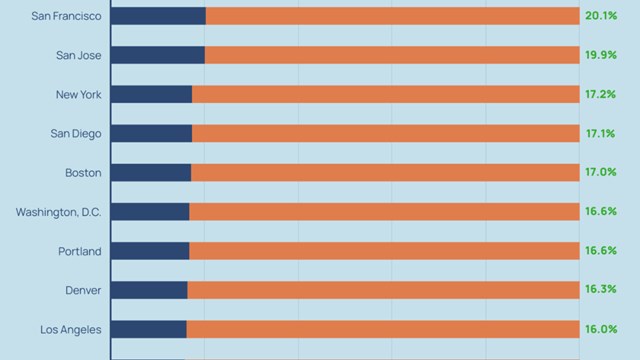Quick: the first residential co-op was created in (a) 2000 BC (b) the 1700’s (c) the 1800’s (d) the 20th century. Now, don’t laugh off choice "a," 2000 BC. While there doesn’t appear to have been co-ops quite that far back, there are records of condominiums. It might be tempting to choose "d," thinking that the notion of popular "cooperation" must surely have its roots in the culture and politics of the 1960’s, but you’d be wrong. The first known co-op in the world was brought into being after a large fire created a serious housing shortage in Rennes, France in 1720, as explained by Richard Siegler and Herbert J. Cooper-Levy, member and former member of the National Association of Housing Cooperatives (NAHC), respectively, in "Brief History of Cooperative Housing," an article in a volume of NAHC’s Cooperative Housing Bulletin.
There is no clear-cut answer as to when the first housing cooperative appeared in the United States. According to Seigler and Cooper-Levy, the first American residential co-op was established over 150 years later in 1876 on West 18th Street in Manhattan. However, Andrew Alpern says in his book, Luxury Apartment Houses of Manhattan, that historian Christopher Gray has determined the site of New York City’s first co-op to be 152 West 57th Street. According to Alpern, that first co-op, the Rembrandt, was erected in 1881 and "was the prototype of a bevy of other cooperative apartment ventures brought to fruition over the ensuing years." He continues, "Of these, the Gramercy, at 34 Gramercy Park, is the oldest one still extant and operating as a co-op."
Whatever and wherever the first cooperative development was, the co-op has survived the twists and turns of ensuing decades from those first settlements to the hundreds that followed. Is there a place for the co-op in the new millennium? Predictions depend upon understanding the history of co-ops; the motives behind their formation and the criteria for their sustenance.
The Co-op’s Evolution
The cooperative movement itself has, of course, cut across a wider range of consumables than housing — it has provided an economical means of obtaining a variety of goods and services, from groceries to electricity, credit unions to cars. Benjamin Franklin created the first co-op of any sort in the U.S., a mutual insurance company, in 1752.
The most famous of the early cooperators were a group of factory workers in Rochdale, England at the beginning of the Industrial Revolution in 1844. They pooled the little money they had to rent a tiny store and purchase food staples in quantity, which they then sold to each other at low prices. One of the members drew up a set of guiding principles which influences co-ops to this day. These included such elements as voluntary and open membership, democratic member control, autonomy, and concern for community.
The first American co-op and several that followed, were developed by well-to-do people who wanted the advantages of owning their own homes with fewer responsibilities. According to Siegler and Cooper-Levy, the buildings were deliberately hybrid, that is, only 40 to 50 percent of the occupants were owners. The rest were tenants whose rent, in fact, covered most of the building’s maintenance expenses.
These buildings weren’t known as co-ops back then; they were called "home clubs." Neil Binder, a principal of Bellmarc Realty, a real estate brokerage firm in Manhattan, says that part of the initial purpose of these clubs was social. "People were getting together and creating camaraderie, and would decide they wanted to build apartments together." Alpern explains the appeal of these cooperative arrangements by discussing the home clubs of Philip Gengembre Hubert, the architect of the Rembrandt: "Hubert dubbed his ventures ‘Hubert Home Clubs,’ capitalizing on both the aristocratic pretensions and snob appeal of the word ‘club,’ and at the same time emphasizing that his offerings were permanent ‘homes,’ rather than mere hotel-like accommodations or lowly tenement flats such as might be occupied by working classes."
The next wave of popularity for cooperative living came in the 1920’s, when the urban population boomed after World War I and individual houses became more expensive. There were many luxury co-ops, some of them incredibly expensive. A big drawing card for the wealthy was the exclusivity; they screened prospective tenants rigorously on personal, as well as financial, levels. There were also middle and low income co-ops that sprang up, thanks to the New York Housing Act of 1927 which provided tax incentives for their creation. Labor Unions such as the Amalgamated Clothing Workers Union became active in building co-ops for workers.
The Depression proved disastrous for co-ops. Tenant-shareholders defaulted on their monthly payments, and the remaining owners found themselves unable either to sell their shares or cover the gap left by the defaulters. As a result, nearly all the buildings went under by 1934.
When co-ops next appeared on the scene, in the 1940’s, it was again the result of legislation. This time it was rent control provisions that led landlords to convert many buildings to co-ops. While rents were fixed; expenses continued to climb, and landlords had to find a way to deal with the situation. Conversion provided an answer. At the same time, trade unions renewed their creation of co-ops, and there were some consumer-driven developments as well.
In 1950, Section 213 of the National Housing Act was passed, providing for government insurance of mortgages. Siegler and Cooper-Levy report that this "permitted private builders to initiate cooperative housing projects without consumer participation or control in the development of the projects." While this brought its own problems –frequently the resident owners took over only to find construction flaws (they would sue and generally settle out of court)–these co-ops were still a good deal, and people sought to make the most of them. Cooperators in the ‘50s created a federation to share information. Now known as the Federation of New York Housing Cooperatives, the organization provides education, assistance and advocacy to New York co-op and condo owners.
The 80’s Conversion Boom
In 1979, a further impetus to increase co-op conversion occurred. Binder explains, "With the Arab oil embargo, oil prices went into the stratosphere. The city was under tremendous pressure from people of moderate income to keep rents down. Landlords were between a rock and a hard place. They had to pay oil prices and 18 to 19 percent prime rates; yet the rent stabilization board didn’t allow enough of a rent increase to cover those costs." Once again, many sought to use co-op conversion to come up with cash. While rising maintenance costs were definitely a factor, the impetus for the 80s conversion boom probably stemmed mainly from landlords’ sheer lack of ability to make a profit on their buildings. The huge discrepancy between the market value of co-ops and the substantially lower rents allowed landlords under rent stabilization led landlords to convert in droves.
The stabilization law enacted in 1969 regulated rents in New York City for buildings constructed after 1947 with six units or more and in previously decontrolled units in buildings built prior to 1947 of six or more units. The eventual outcome of these regulations was that buildings’ values were incredibly suppressed by the 80s. It was difficult, if not impossible, for landlords to make any money on regulated rentals. Converting these rentals to co-ops provided a way to get around the rent regulations. Landlords, or investors to whom they sold the buildings, realized the opportunity to split the difference between the market value of apartments and their rent-regulated value with potential owners. Bruce Cholst, an attorney with Rosen and Livingston in Manhattan, explains the negotiation, "Because tenants have a right to stay under rent laws, the sponsor offers discounts–insider prices–to tenants." Since tenants have just as much of an opportunity to make money off the deal as sponsors do, buying the apartment at still less than the market value, many stayed with the buildings and the conversions took place at a rapid level. It was a logical conclusion of the 80s market.
Greg Carlson, president of the Federation of New York Housing Cooperatives, explains the situation and its eventual evolution: "In the early ‘80s, the economy was good. Banks were lending, no questions asked. Co-op sponsors didn’t take into account that there could ever be a depression, and this came back to bite them." The market crash of ‘87 sent many co-ops under. "It was the buildings with all the financial gimmickry, like wrap mortgages [where the pre-existing mortgage is incorporated into a large mortgage held by the sponsor], that most frequently defaulted," Carlson explains. "At the same time, a number of sponsors realized they didn’t have to sell, but could rent at non-rent-stabilized prices, which kept them from having to default."
Today’s Market
In the ‘90s, there were very few new co-ops or conversions. Binder feels that consumers are more attracted to condos, because their ability to rent out their apartments is less restricted than in co-ops. According to Michael J. Wolfe, president of Midboro Management, Inc., "There was a movement a few years ago to convert cooperative corporations into condominiums, but the paperwork and legal costs far outweighed the advantages and it never became a trend... It is also interesting to note that much of the new construction today is rental. And as long as these rentals continue to command high prices and steady income for developers, there will be little conversion."
Even though financial motives seem to have increasingly become the sole criteria for deciding whether or not to create co-ops, it doesn’t mean that, in the end, members don’t appreciate the nature of their arrangement. It goes back to the early social reasoning in creating the co-ops in the first place. "Yes, you have to live with the rules that the whole co-op has made," concedes Mary Ellen Goodman, who has lived in a co-op in Greenwich Village for 30 years, "but by the same token, when there’s a leak in the building, it’s viewed as everyone’s problem. You’re not alone."
Ms. Goodman is a freelance writer living in Westchester.







2 Comments
Leave a Comment